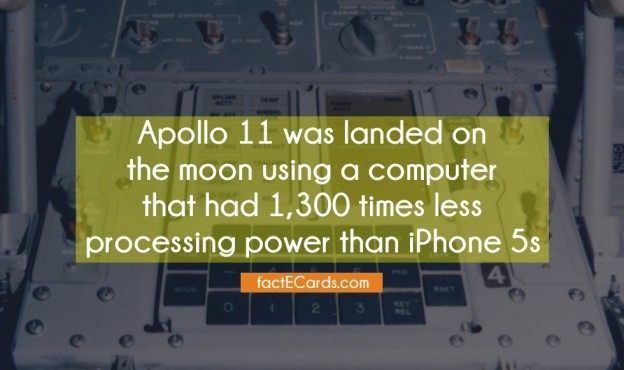The computer aboard apollo 11 for the moon landing had less computing power than a ti 83 calculator

The computer aboard Apollo 11: “Less Powerful than a TI-83 Calculator”
 Image source: Psychology Today
Image source: Psychology Today
 Image source: Reddit
Image source: Reddit
The Apollo 11 mission achieved an incredible feat by landing humans on the moon for the very first time in history. When we think of this groundbreaking accomplishment, images of the enormous Saturn V rocket and the brave astronauts Neil Armstrong, Buzz Aldrin, and Michael Collins often come to mind. However, there’s another important component that played a vital role in the success of this mission: the computer aboard Apollo 11.
The Powerhouse Behind the Moon Landing
The computer system aboard Apollo 11 was known as the Apollo Guidance Computer (AGC). Developed by the Massachusetts Institute of Technology (MIT), this computer was responsible for performing crucial calculations and guiding the spacecraft during its lunar descent and ascent. It was a marvel of technology for its time, but when compared to today’s standards, the computing power of the AGC seems quite minimal.
Computing Power Comparison
Believe it or not, the computer aboard Apollo 11 had less computing power than a TI-83 calculator that many high school students used later on. The AGC had a processing speed of about 0.043 MHz, equivalent to a little more than 43,000 instructions per second. In contrast, the TI-83 calculator, which was released in 1996, had a processing speed of 6 MHz, making it approximately 140 times more powerful than the computer aboard Apollo 11.
The Impact of Limited Computing Power
Considering the limited computing power available on Apollo 11’s computer, it is staggering to think about the complexity of the tasks it needed to perform. From calculating the spacecraft’s trajectory to precisely timing the lunar module’s landing and navigation, the AGC had to deliver accurate results while operating within strict constraints.
The restricted computing power meant that the computer had to use clever programming techniques to optimize its performance. Programmers carefully crafted the software to ensure that it made the most efficient use of the AGC’s limited capabilities. This optimization allowed the computer to handle complex navigation calculations with precise timing, ensuring the safe landing and subsequent takeoff from the moon’s surface.
Evolution of Computing Power
The comparison between the Apollo 11 computer and a TI-83 calculator highlights the astounding progress made in the field of computing since the 1969 moon landing. Today, our smartphones have far more processing power than the entire Apollo Guidance Computer system. The exponential growth of computing power over the past decades has transformed our world, enabling advancements in various fields such as science, medicine, and communication.
Wrapping Up
The computer aboard Apollo 11, despite its limited computing power, played a crucial role in the success of the moon landing. Its innovative programming and optimization allowed the astronauts to navigate and land safely on the lunar surface. As we look back on this historic mission, it serves as a reminder of how far technology has come and the incredible achievements we can accomplish with even the most humble beginnings.
Source: Psychology Today
Share
Related Posts
Quick Links
Legal Stuff

